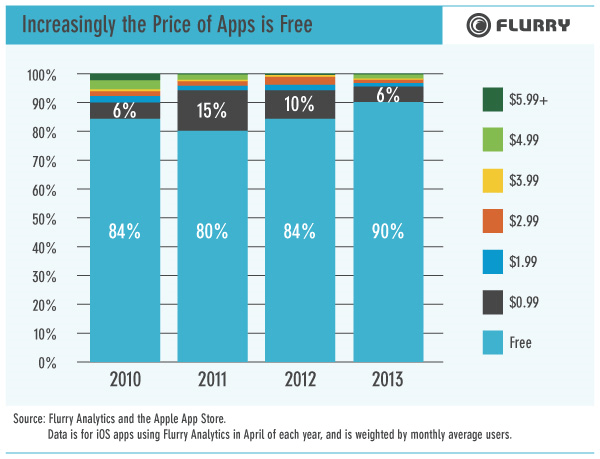People inevitably have to make a choice when it comes to mobile applications. They either have to pay for entertainment with their wallets, or with their eyes. According to mobile analytics firm Flurry, consumers overwhelmingly choose to endure advertising instead of taking the $.99 hit. The study looked at purchasing data gathered over a four year period, which carefully tracked upwards of 350,000 apps.
Flurry first investigated the percentage of iOS apps that employ each method. At this point in time, approximately 90% of all iOS apps are offered free of charge, while 6% are sold for just $.99. This data can be compared to 2011, when only 80% of apps were free and 15% carried the $.99 price tag.
Witnessing such a disparity over a two year period might suggest that developers are forcing the issue; however, it would appear that content producers are simply providing the public with what they want. Flurry wrote in their blog post, "People want free content more than they want to avoid ads or to have the absolute highest quality content possible."

Nevertheless, these stats are simply generalizations, and actual percentages do vary by category. For example, financial and productivity apps are traditionally more expensive than games, and aim to provide a less obtrusive, ad-free experience.
It is also interesting to see how app prices differ depending on the mobile manufacturer and model. As of April, the average cost of an iPhone app is $.19, while iPad apps have a much higher average cost of $.50. Interestingly, Android apps retail for just $0.06 on average. Flurry points out that these figures may in fact coincide with the higher incomes of Apple consumers, especially those who own iPad devices.
Furthermore, lower initial prices might not actually mean that users are paying any less. App developers are more than happy to build their consumer base with free software, with the intent to sell ad-free versions, subscription services, or expensive in-app purchases at a later date.
As a mobile user, do you prefer to pay for an improved experience, or are mobile ads worth the trade-off?